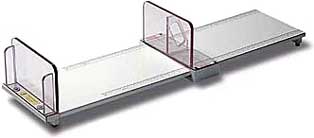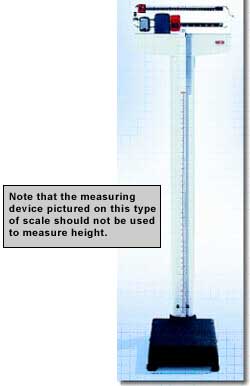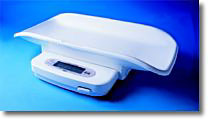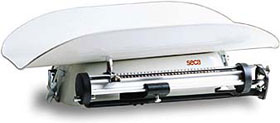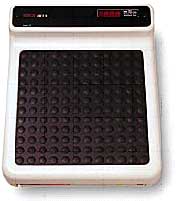The accuracy and reliability of measurements are dependent on the quality of the equipment used
for the measurements. Quality, easily calibrated and well-maintained equipment will be utilized.
Length Boards for Measuring Infants
A recumbent measuring board should have a firm, flat base with an attached measuring tape, a fixed
perpendicular headpiece and a smoothly sliding foot piece constructed of a durable material like
wood or plexiglass that is easy to clean. The foot piece must form a 90º angle with the measurement
surface. All edges must be smooth and finished. Measurements should be readable to the nearest 1/8
inch. The board should be placed on a secure table with enough room for the Assistant to be able
to stand behind the back of the head of the child.
Stadiometers for Measuring Children and Adolescents
Two types of stadiometers are acceptable for measuring older children and adults. One type is a measuring
board mounted to the wall with an attached measuring tape and moveable right angle headpiece. It
is important to ensure that the measuring board has been accurately mounted. A portable measuring
board with a base for standing upon and a right angle headpiece may also be used. Portable measuring
boards should be on a stable surface. It is also useful to have a step stool or short stepladder
for the staff to stand on to read the height of a person who is taller than the measurer.
Unacceptable Measuring Equipment
The following equipment is unacceptable for measuring infants and children:
- A measuring tape or yardstick alone or attached to a table top
- Measuring between two pencil marks on an exam table
- Length measuring device attached to an infant scale
- Movable measuring rod on platform scales
- Tape measures, yard sticks or paper "growth charts" mounted on the wall
- Books, tissue boxes, etc. should not be used as headpieces
Scales for Weighing Infants
Infant beam balance or digital scales are appropriate to use for weighing infants. Beam balance scales
should be marked in increments of 1 ounce or less. They should have a screw-type zeroing adjustment.
There should be two sliding weights on a beam balance scale, one for whole pound increments and a
second for ounces. Digital scales should read to one ounce or less. Both types should have features
that allow for calibration. The scale must rest on a firm, stable table.
Scales for Weighing Children and Adolescents
A digital scale or an adult beam balance scale with a step-on platform and attached sliding weights
are appropriate to use to weigh children and adults. The scales should measure in increments of 1/4
pound or less. Beam scales should have a screw-type zeroing adjustment. The scale should rest on
firm, uncarpeted floors. The scale should have features that allow for calibration.
Zeroing and Standardization
Daily: Scales should be zeroed daily. Zeroing means that the scale
reads zero when no weight is placed on it.
Monthly: Scales and stadiometers should be calibrated monthly. Scales
should be tested with standard weights. Stadiometers should be checked with a standard length rod.
